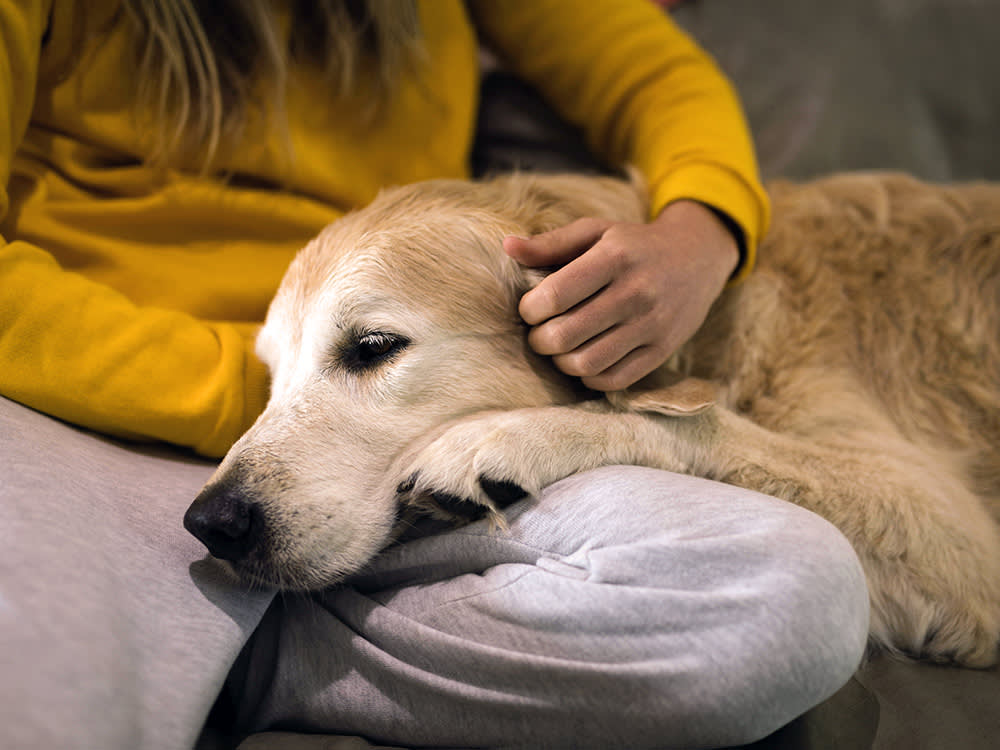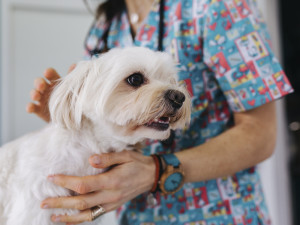Can Dogs Get Fevers?
What to do to help them cool down and feel better.

share article

Your pet wants you to read our newsletter. (Then give them a treat.)
In This Article:
What Causes Fevers in Dogs? opens in a new tabRecognizing Dog Fever Symptomsopens in a new tab How to Take A Dog’s Temperature opens in a new tabHow to Comfort a Dog With a Fever opens in a new tabDog Fever Medications opens in a new tabWhen to Visit a Vet for a Feveropens in a new tab
Just like humans, dogs can get fevers. Veterinary professionals typically define fevers in dogs as rectal temperatures of 102.5 degrees Fahrenheit /39.2 degrees Celsius or greater. If you suspect your pup is feverish, take them to the vet for supportive care, like hydration and medications.
What causes fevers in dogs?
A dog’s normal temperature is between 100 degrees Fahrenheit and 102.5 degrees Fahrenheit (37.7 degrees Celsius to 39.4 degrees Celsius). A pup is considered febrile — aka having a fever — when their temperature is above 102.5 degrees Fahrenheit. A fever develops as a result of the brain telling the body to turn the body’s internal thermostat up. So, what triggers this response?
When a dog’s immune system reacts to something, substances called pyrogens trigger the brain to make the body'’s temperature go up. These pyrogens can come from white blood cells within the body or from foreign organisms, like bacteria. A fever helps the immune system in two major ways: It stimulates immune cells and harms infectious cells. Fevers are helpful, but they’re only helpful to a certain point. Fevers above 106 degrees Fahrenheit can introduce a new set of problems.
Dogs can develop fevers for a number of reasons, including:
Infection (bacterial, viral, or fungal)
Inflammation
Parasites
Exaggerated immune response
Cancer
Fever of unknown origin (sometimes, the cause of a fever is not so obvious)
Fever versus hyperthermia
Hyperthermia is an abnormally high body temperatureopens in a new tab. Dogs develop fevers from internal causes, like the body’s response to a viral infectionopens in a new tab. They develop hyperthermia from external reasons, like going on a long runopens in a new tab on the first hot day of the year. Pro tip: Don’t do thisopens in a new tab.
Ease back into high levels of outdoor activity when the weather warms up. While doggie fevers can get pretty high (like 105 degrees Fahrenheit), dogs with hyperthermia can get extremely hot (like 107 degrees Fahrenheit and higher — yikes!)
Recognizing dog fever symptoms
Dog parents concerned that their pup has a fever may think, “My dog feels hot to the touch” or “My dog’s nose is warm and dry.” The truth is that these are not good ways to determine a pup’s temperature. The only sure-fire way to know if a dog has a fever is to actually measure their body temperature.
Symptoms of fever in dogs may include:
Poor appetite
Lethargy
Shivering
Excessive panting
Stiffness/reluctance to move
How to take a dog’s temperature
The only true way to know if your dog has a fever is to take their temperatureopens in a new tab. The best way to do this is by taking a rectal temperature with a digital thermometer. Depending on your dog’s opinions on the matter, this may not be the easiest way if you’re flying solo.
Another option is to use a veterinary-specific ear thermometer. Studies have shown that ear temperatures can be less accurate than rectal temperatures, but they can be good for monitoring trends (like if your dog’s temperature goes up or down from the last reading). There are also non-contact, infrared thermometers, but studies have shown that these often don’t give reliable results.
So, we’re left with taking butt temperatures. Here’s how to get one:
Gather supplies: You’ll need a digital thermometer and a water-based lubricant or petroleum jelly for lubricating the thermometer tip. You should keep this thermometer separate from the one you and your family use, for (hopefully) obvious reasons.
Grab a buddy (optional): A helping hand can make things easier, especially if your pup gets a little bit squirmy.
Provide a calm environment: Make sure your dog is relaxed. Excitement and activity can temporarily increase their temperature, making it seem like they have a fever when they really don’t.
Use a little lube: Place a small amount of lubricant on the tip of the thermometer.
Insert the thermometer: Lift your dog’s tail and gently insert the thermometer into the rectum about one to two inches. Hold the thermometer in place and wait for the beep (or whatever indication that the thermometer is done taking a measurement).
Keep it clean: Remove the thermometer and wipe it clean.
Reward your dog: Provide treats and snuggles for positive reinforcement.
How to comfort a dog with a fever
Dog fever treatment depends on the cause of the elevated temperature and should be guided by your veterinarian, but pup parents can still provide some comfort for their pups at homeopens in a new tab.
Provide cool places to sleep
Just like people, febrile dogs may seek warmth one minute and cold the next. Provide them with a cozy bed to snuggle up in and also a cool surface (and maybe a fan) where they can try to cool down.
Provide plenty of fresh water
Any issue that can cause a dog to have a fever can also make them not want to eat and drink as much. Make sure your pup has plenty of fresh water at all times. Try to encourage them to drink, but don’t force the issue.
Seek (and follow) your vet’s advice
As soon as you know your dog has a fever, the first call should be to your vet’s office. It may take some testing to determine the cause of your dog’s fever. They may need antibiotics, anti-inflammatories, or more aggressive care. Once a treatment plan is in place, be sure to follow it.
Dog fever medications
Hopefully the article will help you remember what a pup’s temperature should be and how to take it. But above all else, you should remember this: Never use human medications if your dog has a fever. Human medications, like ibuprofen and acetaminophen, can be toxic to dogsopens in a new tab and cause more harm than good. In some cases, giving over-the-counter medications can make it harder for your vet to prescribe what your dog actually needs due to medication interactions.
If you’re wondering, “What can I give my dog for a fever at home?”, here’s what you can give them:
A fresh bowl of water
A cool place to rest
Lots of love
A promise to call a veterinarian ASAP
When to visit a vet for a fever
If your dog has a fever between 102.5 degrees Fahrenheit and 104 degrees Fahrenheit, call your vet’s office to get some advice. They’ll be able to tell you if your dog can wait for an appointment or should be seen right away based on their symptoms. Head to the vet if they have a fever above 104 degrees Fahrenheit. If they have a fever above 105 degrees Fahrenheit, get to the vet, stat.
FAQs (People also ask):
What should a dog’s temperature be?
Normal temperature for a dog is between 100 degrees Fahrenheit to 102.5 degrees Fahrenheit (37.7 degrees Celsius to 39.4 degrees Celsius). This can fluctuate throughout the day depending on size, breed, and activity level. A dog’s temperature is elevated when it’s above 102.5 degrees Fahrenheit.
Does kennel cough cause fever?
Kennel coughopens in a new tab, also called canine infectious respiratory disease complex (CIRDC), is a contagious respiratory infectionopens in a new tab that can be caused by both bacterial and viral pathogens. Dogs with kennel cough often have low grade fevers.
How do I take a dog’s temperature at home?
Dog parents can take their dog’s temperature at homeopens in a new tab by gently inserting a lubricated digital thermometer into their dog’s rectum. Be sure to keep your pup’s thermometer separate from your own.
References:

Dr. Alycia Washington, DVM, MS
Alycia Washington, DVM, is a small animal emergency veterinarian based in North Carolina. She works as a relief veterinarianopens in a new tab and provides services to numerous emergency and specialty hospitals. Dr. Washington is also a children’s book author and freelance writer with a focus on veterinary medicine. She has a special fondness for turtles, honey bees, and penguins — none of which she treats. In her free time, Dr. Washington enjoys travel, good food, and good enough coffee.
Related articles
![Red-haired woman holding sleeping dog in her lap on the bed]() opens in a new tab
opens in a new tab6 Reasons Your Dog Is Vomiting
And how to help them feel better fast.
- opens in a new tab
Does Your Dog Need a Flu Shot?
“Sick as a dog” isn’t just a phrase.
![man and lab puppy on park road]() opens in a new tab
opens in a new tabWhen, Exactly, Should You Vaccinate Your Puppy?
If it’s time for a round of shots (no, not that kind), follow this guide.
![A dog outside with his mouth open coughing]() opens in a new tab
opens in a new tabLaryngitis in Dogs: Causes and Treatment
Vet advice on when you should be worried.
![Man Kissing And Hugging a small white and brown dog.]() opens in a new tab
opens in a new tabA Mysterious Illness Is Making Dogs Across the Country Sick
Get all the info about this highly contagious respiratory illness—including its possible origins.
![Cavalier King Charles spaniel puppy running in a garden]() opens in a new tab
opens in a new tabParvovirus: How to Identify and Treat Parvo Symptoms in Puppies
The potentially deadly virus can be prevented with one simple step.









